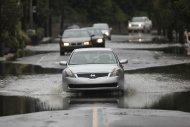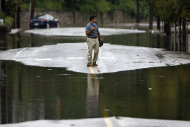WILKES-BARRE, Pa. (AP) — Nearly 100,000 people were ordered to flee the rising Susquehanna River on Thursday as the remnants of Tropical Storm Lee dumped more rain across the Northeast, socking areas still recovering from Hurricane Irene and closing major highways at the morning rush.
At Binghamton, N.Y., the wide river broke a flood record and flowed over retaining walls downtown. Interstate 88 was closed and emergency responders scrambled to evacuate holdouts who didn't heed warnings to leave neighborhoods.
About 80 miles downstream in Wilkes-Barre, the river was projected to crest later Thursday at 41 feet — the same height as the levee system, officials said. Residents were ordered to leave by 4 p.m.
There was also flooding in Oneonta, N.Y., where Tom Connelly was camping by the river Wednesday night as the water began rising.
"Within a half hour — less than a half hour — it really overflowed its banks and I really almost didn't have enough time to get out of there," Connelly said. "By the time I left the tent, the water was within 2 feet. ... I'm sure the tent is long gone."
Wet weather followed by Hurricane Irene and its remnants have saturated the soil across the Northeast, leaving water no place to go but into already swollen creeks and rivers. Many areas flooding this week were spared a direct hit by Irene, but authorities took no chances in the same places inundated by historic flooding after Hurricane Agnes in 1972.
The National Weather Service predicted 4 to 10 inches of rain across the mid-Atlantic and Northeast through Thursday. Flood watches and warnings were in effect from Maryland to New England.
The service said the river level in Binghamton is above 25 feet, higher than the record set in 2006 and more than 11 feet above flood stage. It's expected to rise another foot or so.
Evacuation orders were issued Wednesday to some 20,000 people in Binghamton and neighboring communities along the Susquehanna. More than 70,000 residents in Wilkes-Barre and Kingston were told to leave. So were people in about 170 homes about 90 miles downstream in Harrisburg, where crews put sandbags around the governor's mansion.
Wilkes-Barre Mayor Tom Leighton said residents should prepare for an evacuation of 72 hours and advised them to take clothing, food and prescription medicine. He also asked city businesses to close their doors by noon.
The evacuations come as the remnants of Lee, which has caused flooding and power outages across the South since hitting the Gulf Coast last week, slogged northward. At least nine deaths have been blamed on Lee and its aftermath.
In New Jersey, where many residents were still cleaning up after Irene, the remnants of Lee were expected to drop anywhere from 2 to 5 inches of rain. There was some flooding along rivers including the Passaic, which breached its banks during Irene and caused serious damage. Heavier flooding is expected Thursday.
Roads and highways closed around the region. In Philadelphia, flooding and a rock slide closed the eastbound lanes of the Schuylkill Expressway, a major artery into the city, and it could take hours for the road to reopen.
Flash flooding shut down roads and closed schools in many parts of Pennsylvania. A bridge spanning the Delaware River between New Hope, Pa., and Lambertville, N.J., closed Thursday morning as flood waters carried debris downriver.
In New York, the Thruway Authority expected Thursday to close a 105-mile stretch of Interstate 90 where it runs along the Mohawk River, which had overflowed its banks in some areas. It's the state's most heavily traveled east-west highway.
A flood watch was in effect through Thursday afternoon in soggy Vermont but officials on Thursday said that rain has caused only minor problems in the state. Parts of the state are still recovering from flooding from the remnants of Irene, which was a tropical storm by the time it swept over the area.
In New York, Prattsville was cut off on Wednesday afternoon, its main roads covered with water as public works crews tried to dredge the creeks to alleviate the flooding. Trash bins stood in the mud-caked streets to collect debris left by Irene and the wreckage of houses destroyed by the earlier storm still dotted the area.
Residents were ready to evacuate as the Schoharie Creek escaped its banks and smaller streams showed significant flooding. In nearby Middleburgh, dozens of residents were evacuated from temporary shelters set up in schools, many for the third time since Irene hit.
Lee formed just off the Louisiana coast late last week and gained strength as it lingered in the Gulf for a couple of days. It dumped more than a foot of rain in New Orleans and trudged across Mississippi and Alabama.
Tornadoes spawned by Lee damaged hundreds of homes, and flooding knocked out power to hundreds of thousands of people. Trees were uprooted and roads were flooded. Winds fanned wildfires in Louisiana and Texas, and the storm even kicked up tar balls on the Gulf Coast. At least six people have died in the South and Northeast.
The rainy remnants of Agnes devastated the Susquehanna River basin in 1972 after moving up the coast. At the time it was one of the most damaging hurricanes ever recorded despite being a relatively weak storm.
Meanwhile, in the open Atlantic, Hurricane Katia brought rough surf to the East Coast but was not expected to make landfall in the U.S. Tropical Storm Maria also formed Wednesday far out in the Atlantic, but it was too soon to tell if and where it might make landfall.



No comments:
Post a Comment